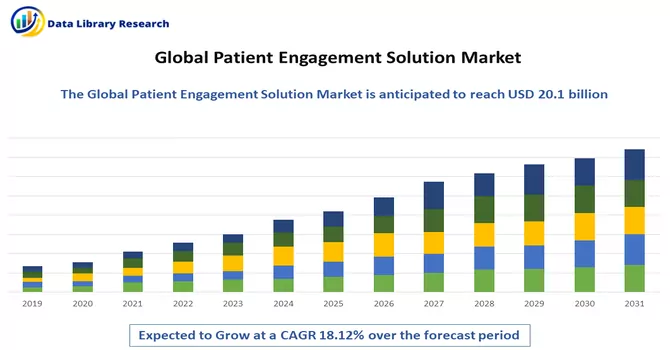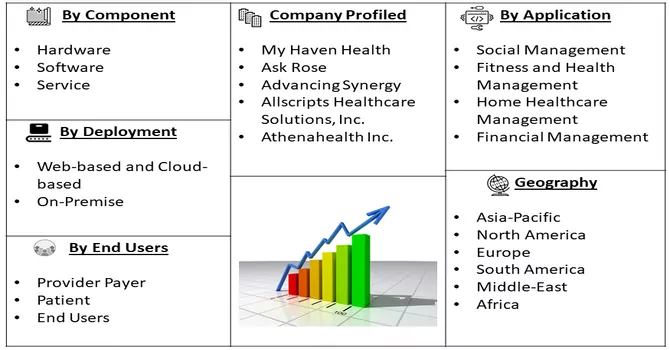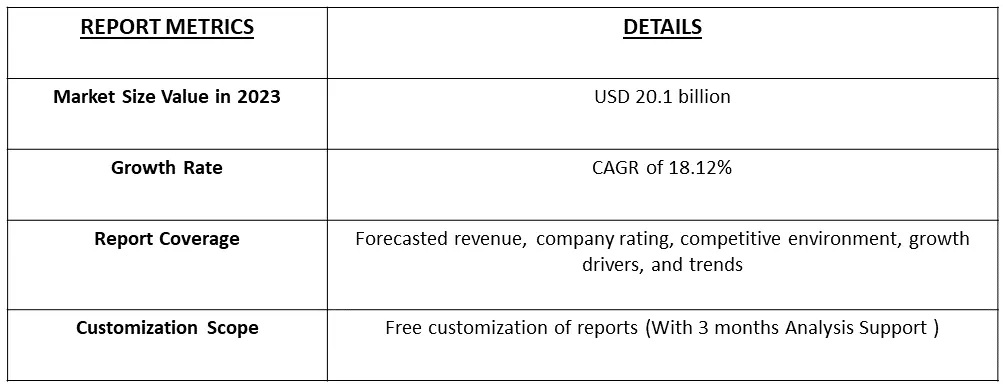The global patient engagement solutions market size was valued at USD 20.1 billion in 2022 and is expected to grow at a CAGR of 18.12% over the forecast period, 2023 to 2030.

Get Complete Analysis Of The Report - Download Free Sample PDF
The patient engagement solution industry plays a pivotal role in developing and implementing technologies, strategies, and tools that actively involve patients in managing their healthcare journey. This sector is dedicated to fostering effective communication, collaboration, and participation between patients and healthcare providers, with the overarching goals of improving health outcomes, enhancing patient satisfaction, and boosting overall healthcare efficiency. A significant transformation is underway in the healthcare landscape, shifting towards a patient-centered care model that places emphasis on involving patients in decision-making processes and treatment plans. Patient engagement solutions serve as instrumental facilitators in this paradigm shift by offering tools that enable robust communication and shared decision-making between patients and healthcare professionals.
The relentless advancement of health information technology, encompassing electronic health records (EHRs), mobile applications, and telehealth platforms, has paved the way for the evolution of patient engagement solutions. These cutting-edge technologies provide patients with convenient and accessible means to interact with their healthcare providers, access pertinent medical information, and actively manage their own health.
The trend of integrating patient engagement solutions with telehealth platforms is experiencing significant growth. This acceleration has been particularly propelled by the impact of the COVID-19 pandemic, and it continues to redefine the dynamics of how patients remotely engage with healthcare providers. Additionally, the widespread adoption of mobile health applications further contributes to the evolution of patient engagement practices. These applications offer a suite of features, including appointment scheduling, medication reminders, health monitoring, and secure communication with healthcare providers. Consequently, these tools play a pivotal role in empowering patients to actively participate in and manage their healthcare journey.
Market Segmentation:The Patient Engagement Solution Market is segmented by Component (Hardware, Software, and Service), Delivery Mode (Web-based and Cloud-based, and On-Premise), Application (Social Management, Fitness and Health Management, Home Healthcare Management, and Financial Management), End User (Provider Payer, Patient, and Other End Users), and Geography (North America, Europe, Asia-Pacific, Middle East and Africa, and South America). The report offers the value (in USD million) for the above-mentioned segments.

For Detailed Market Segmentation - Download Free Sample PDF
Market Drivers:
Growing Emphasis on Value-Based Care
The momentum towards value-based care models is a key catalyst in propelling the patient engagement solution industry forward. Value-based care places a strong emphasis on enhancing patient outcomes while concurrently lowering healthcare costs. Within this framework, patient engagement solutions assume a pivotal role by actively engaging patients in their healthcare journey, advocating for preventive measures, and aiding in the ongoing management of chronic conditions. Also, in the present landscape where healthcare providers are incentivized to deliver high-quality, cost-effective care, the demand for patient engagement solutions that align with and contribute to these objectives is consistently on the rise.
Technological Advancements and Digital Health Adoption
The rapid technological advancements and the widespread adoption of digital health solutions are driving the patient engagement solution market. Furthermore, the evolution of health information technology, mobile applications, wearables, and telehealth platforms has created new opportunities for patient engagement. These technologies enable real-time communication between patients and healthcare providers, facilitate remote monitoring, and provide patients with tools to actively participate in their care. As patients become more tech-savvy and demand digital solutions that enhance their healthcare experience, the industry is propelled by ongoing technological innovations.
Market Restraints:
Limited Interoperability and Standardization
Interoperability challenges and a lack of standardized practices across healthcare systems restrain the seamless integration of patient engagement solutions. Many healthcare systems use different electronic health record (EHR) systems, and interoperability issues can arise when attempting to integrate patient engagement solutions with these diverse systems. The lack of standardized data formats and communication protocols hinders the smooth flow of information between different platforms. This can lead to fragmentation of patient data, reduced efficiency, and barriers to the comprehensive, patient-centric care that engagement solutions aim to provide. Furthermore, privacy and security concerns related to patient health data pose a significant restraint on the patient engagement solution industry.
Also, patient engagement solutions involve the collection, storage, and transmission of sensitive health information. Ensuring the privacy and security of this data is crucial to gaining and maintaining patient trust. Concerns about data breaches, unauthorized access, and inadequate cybersecurity measures can hinder the widespread adoption of patient engagement technologies. Striking the right balance between usability and robust security measures is a challenge for the industry, as regulatory compliance and data protection become increasingly stringent.
The integration of patient engagement solutions with telehealth platforms is on the rise. This trend was accelerated by the COVID-19 pandemic, and it continues to reshape how patients interact with healthcare providers remotely. Increasing use of mobile health applications for patient engagement. These apps provide tools for appointment scheduling, medication reminders, health monitoring, and secure communication with healthcare providers, enhancing patient involvement in their care.
Segmental Analysis:
Hardware , Software and Service Segment is Expected to Witness Significant Growth Over the Forecast Period.
The earable devices, such as smartwatches and fitness trackers, continue to play a significant role in patient engagement. These devices enable patients to monitor vital signs, physical activity, and other health metrics. The integration of remote monitoring tools into these wearables enhances real-time data collection, supporting proactive healthcare interventions. Telehealth software has become a cornerstone of patient engagement, facilitating virtual consultations, remote follow-ups, and telemedicine services. User-friendly interfaces, secure communication features, and integration with other healthcare systems contribute to the success of telehealth software. Patient engagement services often include educational resources and support services. These services aim to enhance health literacy, empower patients to make informed decisions about their care, and provide ongoing support for managing chronic conditions. Thus, owing to such advantages, the segment is expected to witness significant growth over the forecast period.
Web-based and Cloud-based Segment is Expected to Witness Significant Growth Over the Forecast Period.
Web-based patient engagement solutions are applications or platforms that users access through a web browser. These solutions are hosted on servers and can be accessed using a URL, allowing users to interact with the platform using a web interface. Cloud-based patient engagement solutions leverage cloud computing infrastructure to deliver services over the internet. The solution is hosted and managed by a cloud service provider, and users access it remotely. Thus, owing to such advantages, the segment is expected to witness significant growth over the forecast period.
North America Region is Expected to Witness Significant Growth Over the Forecast Period.
North America boasts advanced healthcare infrastructure with well-established hospitals, clinics, and healthcare systems. This infrastructure facilitates the integration and adoption of patient engagement solutions. The region has been at the forefront of adopting health information technology. The widespread implementation of electronic health records (EHRs) and other health IT systems provides a foundation for the integration of patient engagement solutions. Regulatory frameworks, including initiatives like the Centers for Medicare & Medicaid Services (CMS) programs in the United States, emphasize patient-centered care and value-based reimbursement. This encourages healthcare providers to invest in patient engagement solutions to enhance care quality and outcomes.
Furthermore, the growth of the market is further fueled by various initiatives undertaken by key industry players. For example, in June 2020, IBM and Wipro joined forces to facilitate Wipro customers in seamlessly and securely transitioning to a hybrid cloud environment. This collaboration aims to empower Wipro in developing hybrid cloud offerings that assist businesses in migrating, managing, and transforming critical workloads and applications across public or private cloud and on-premises IT environments.
Similarly, in February 2021, Humana (US) partnered with IBM (US) to implement IBM Watson Assistant for Health Benefits, an AI-enabled virtual agent housed in the IBM Watson Health Cloud. This virtual agent enhances the member experience for Humana Employer Group members by providing greater clarity and transparency on benefits and related matters. Initiatives like these are anticipated to drive market growth during the forecast period. With a higher receptivity to innovative technologies and increasing awareness among the general population about.

Get Complete Analysis Of The Report - Download Free Sample PDF
In this emerging market, characterized by its relative novelty, a surge of new entrants is reshaping the landscape. A majority of these players are rooted in developing countries, leveraging advanced technologies. However, in the era of seamless global connectivity, these entrants are not confined to their home territories; they are actively expanding into developing nations, seeking to establish a foothold in these markets. Simultaneously, there is a notable emergence of new players originating from these developing countries.Adding to the dynamism of the sector, several startups have entered the scene, presenting stiff competition to established companies. Noteworthy among these startups are and global players are:
Recent Developments:
1) In March 2022, DeliverHealth launched its partner program. DeliverHealth program supports strategic partners within the eco-system, growing sales domestically and internationally while enabling healthcare organizations to simplify the daily complexities of healthcare, improve patient outcomes and reduce overall costs.
2) In March 2022, the EHR vendor Epic launched its first-ever customer relationship management technology for health systems called Cheers. The EHR vendor developed Cheers after several Epic customers requested capabilities to better connect with patients, especially as COVID-19 strained health systems.
Q1. What was the Patient Engagement Solution Market size in 2022?
As per Data Library Research The global patient engagement solutions market size was valued at USD 20.1 billion in 2022.
Q2. At what CAGR is the Patient Engagement Solution Market projected to grow within the forecast period?
Patient Engagement Solution Market is expected to grow at a CAGR of 18.12% over the forecast period.
Q3. Which region has the largest share of the Patient Engagement Solution Market? What are the largest region's market size and growth rate?
North America has the largest share of the market. For detailed insights on the largest region's market size and growth rate request a sample here
Q4. What are the factors driving the Patient Engagement Solution Market?
Key factors that are driving the growth include the Growing Emphasis on Value-Based Care and Technological Advancements and Digital Health Adoption.
Data Library Research are conducted by industry experts who offer insight on industry structure, market segmentations technology assessment and competitive landscape (CL), and penetration, as well as on emerging trends. Their analysis is based on primary interviews (~ 80%) and secondary research (~ 20%) as well as years of professional expertise in their respective industries. Adding to this, by analysing historical trends and current market positions, our analysts predict where the market will be headed for the next five years. Furthermore, the varying trends of segment & categories geographically presented are also studied and the estimated based on the primary & secondary research.
In this particular report from the supply side Data Library Research has conducted primary surveys (interviews) with the key level executives (VP, CEO’s, Marketing Director, Business Development Manager and SOFT) of the companies that active & prominent as well as the midsized organization
FIGURE 1: DLR RESEARH PROCESS

Extensive primary research was conducted to gain a deeper insight of the market and industry performance. The analysis is based on both primary and secondary research as well as years of professional expertise in the respective industries.
In addition to analysing current and historical trends, our analysts predict where the market is headed over the next five years.
It varies by segment for these categories geographically presented in the list of market tables. Speaking about this particular report we have conducted primary surveys (interviews) with the key level executives (VP, CEO’s, Marketing Director, Business Development Manager and many more) of the major players active in the market.
Secondary ResearchSecondary research was mainly used to collect and identify information useful for the extensive, technical, market-oriented, and Friend’s study of the Global Extra Neutral Alcohol. It was also used to obtain key information about major players, market classification and segmentation according to the industry trends, geographical markets, and developments related to the market and technology perspectives. For this study, analysts have gathered information from various credible sources, such as annual reports, sec filings, journals, white papers, SOFT presentations, and company web sites.
Market Size EstimationBoth, top-down and bottom-up approaches were used to estimate and validate the size of the Global market and to estimate the size of various other dependent submarkets in the overall Extra Neutral Alcohol. The key players in the market were identified through secondary research and their market contributions in the respective geographies were determined through primary and secondary research.
Forecast Model
